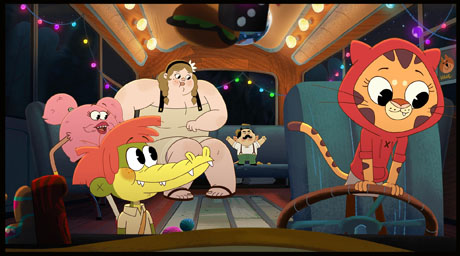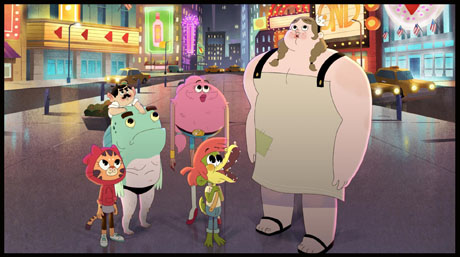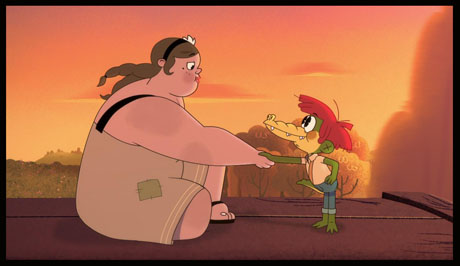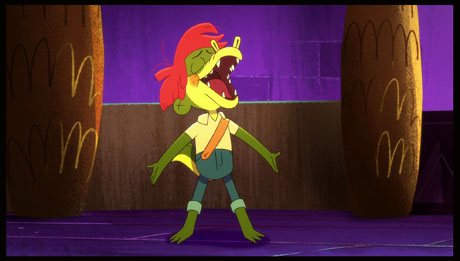
My first interview for Animation Scoop, back in July 2016, was with Ryan Crego. At the time, he was the executive producer of DreamWorks Home: Adventures with Tip and Oh series. Now he’s given Netflix a new, original, hand-drawn animated musical. Arlo the Alligator Boy debuts this Friday April 16th, and Crego can’t wait for families to experience it. (This interview was edited for length.)
Ryan Crego: It’s crazy to be at this point in the process where it’s finally coming out. It’s slightly surreal.
Jackson Murphy: It’s a 2D adventure comedy musical extravaganza. And is it true that you’ve had the idea for this movie – and these characters – for about a decade?

RC: It’s true. It’s crazy to think about. I developed the movie when I was a different version of myself (laughs). Before being a dad. Before being married. I was finally able to realize the vision. Big kudos to Netflix for seeing the potential and jumping on board and allowing me to make it. It’s been over 10 years, and I think my own personal growth has allowed me to put the vision together in a more… entertaining and exciting way than I ever could have when I first came-up with the idea. It’s a great lesson in perseverance and personal growth and not giving up on something that you think is a good idea. I couldn’t be more happy. It’s extremely emotional at times to think about the journey and then realize, “Here it is! Here we go!”
JM: What a big culmination moment we’re in now with the film coming out. So when we talked in July 2016 for Home: Adventures with Tip & Oh, were you thinking, “Gosh – with the relationship I have with Netflix, maybe this is more of a possibility”? And at what point did you really think this is really going to happen?

Ryan Crego
But I really wanted to do something that was totally original, and it was really my wife who was championing this idea because… it wasn’t that I had given up on it. But when you kind of put something out there in the world and it doesn’t end up the way you see it and you kind of… I don’t want to say reject it, but slightly (laughs)… it takes someone breathing confidence in it to get you to re-open and potentially have that wound again. And it was really my wife who did that for me and was like, “You need to go for it.” I started re-developing it, and I fell in love with the idea again and started working on it. And before you knew it, I found a home with Netflix. They were so cool about going on board with a 2D animated feature that’s a modern musical. They were just like, “Yes! Yes! Yes!” We launched into it very quickly.
JM: Props to your wife for all of that. You mentioned earlier that this has been a journey for you, and speaking of journey, that’s what Arlo the Alligator Boy goes through. He leaves the swamp to look for his dad in The Big Apple. You make New York City so vibrant and so elegant. Why was that so important to you?
RC: I love New York. I love the city. I’m actually from the Bay Area, and it’s so funny because I realized while I was doing this… San Francisco is the place that absolutely has my heart and I’m afraid to touch that city. I love New York. I love everything from grit to polish of that city. It’s fascinating to me how much exists in such a small area. And it’s a city you truly look up to and it feels aspirational. For a character like Arlo who has never seen the world before – to be thrown into a place like this, it felt like a really neat place for him to end up.

JM: And there’s a portion of the movie later on that’s all about the Met Gala. There’s so much fashion and interior design of it. How did you approach doing the design for everything involving the Met Gala?
RC: Definitely wouldn’t have been even close without our art director Israel Sanchez and his team. He came on early and really helped design and define the look of the world, and he brought on some artists that were so in-tune… and some who had lived in New York and lived and breathed that lifestyle. I was always really surprised with how well they captured those elements. In the later phase of the movie as we were really plusing and pushing ourselves to get it right and go deeper, that’s when a lot of the costuming came out. We really wanted it to be exciting. They put a lot into it. I think it’s a really fun place to have the climax of the film because it’s such a wild scene and our characters who are also unique in their own light feel like they blend into that world a little bit.
JM: At the center of this movie, you have this very special relationship between Arlo and Bertie that is sweet and very delicate. Was this the most difficult element you made sure you got right because of the delicacy?
RC: I don’t know if it was the most difficult, and the reason I say that is because… I think it was maybe the most important. Along the course of making the movie, I really fell in love with both of these characters and the actors who play them, Michael J. Woodard and Mary Lambert, who embody the characters and really took [them] on. Once we were recording them and had them cast, I really understood the characters and their dynamic. We recorded them together for about a week where we did some music early on, and during that week I totally fell in love with them as people. We became a family. And then it started to lock into a place in a way that it never had before. It felt very natural and organic in that way. The movie, for me, as a filmmaker and storyteller, the movie is all about that relationship. That’s the most interesting piece and driver of the film.
JM: Yes, I would agree with that. It’s very strong. You also have Tony Hale, Jennifer Coolidge, Annie Potts and Jonathan Van Ness – great voice talent. How was it working with all of them, and what surprised you about them?
RC: All of them are amazing. We were so lucky. You never know until you get to work with somebody what their interest level is going to be – how invested they were going to be. And we were so lucky that everyone who stepped in the booth for this project read the script, loved the script, saw the value, saw the potential and brought everything to the table. Annie Potts was one of the first records we had done, and I was a little intimidated. (laughs) And she had just come off of doing Toy Story 4. “I hope she likes it and likes working with me.” She was so sweet and so loving and so enthusiastic for the property.

Some of the really cool surprises: working with Flea from the Red Hot Chili Peppers, a group who defined my youth. To be standing across the room from someone like that and for him to say at one point, “This movie has such a sweet soul to it.” It was so clear he was invested in it. And I was like, “Wow. I did something that Flea liked.” (laughs) That’s really neat. Whatever happens from this point on, I feel like I nailed it. Everyone always wants to know: Jonathan Van Ness is actually that guy. Such an entertaining and bright and brilliant person. He gives it everything. A lot of the actors – Jennifer Coolidge, Tony Hale and Brett Gelman included – a lot of ad-libbing in the movie, just turning them loose and letting them discover their characters and allowing them to perform and make decisions.
JM: And you co-wrote many of the songs in the movie as well. How was it for you trying to figure out the flowing feel of it… from song to song and story to song and character development and balancing all of that?
RC: That was a new discovery for me, and that was probably the most fun part of this process for me and where I grew the most as a storyteller. I grew up playing music. My grandpa taught me my first guitar chords when I was 12. I’ve always been around music and playing music in bands and travelling. I kind of put it aside to really focus on animation. Getting into the movie, I brought on my songwriting partner and the composer of the movie, Alex Geringas. My intention was for Alex to write all of the songs. As we got into the process, it just became so clear because I was so in-touch with the characters, story and motivation, Alex was the one who was like, “You have to be here. I want you to write these songs with me.”

JM: You’ve had an interesting career, going from some of those DreamWorks animated movies you mentioned, including Kung Fu Panda 2 and Puss in Boots (which are both celebrating their 10th Anniversaries this year) as a story and storyboard artist. You then went to television with the Home TV series and now you’re directing an animated feature. Were there things that surprised you about directing a feature as opposed to working in a different way on a feature and working and shepherding a television series?
RC: I feel like I’ve worked so hard to get to the point where someone would actually say “Yes, you can direct a feature.” That’s always been a dream. Once I got my claws into it, I was relentless in my work ethic and taking advantage of that situation. I don’t wanna sound cocky… I think I felt ready for it. Ready for the challenge. Then it was a matter of, “How do I make this happen?” All of the TV training was really great. We didn’t have the same resources you would have if you were making a Shrek [film]. We were definitely on a much shorter timeframe and smaller budget, but working in TV you get used to that. You get used to those limitations. I really felt like I was able to take a lot of my TV training, pair that with making features and stuff I had learned when I was younger and also bring in a lot of storyboard artists. A lot of our team were TV board artists who had never worked on a feature before, which was great because they got in the trenches and just started going.
JM: And this is not the only time that we’re gonna see these characters because we’ve got this I Heart Arlo TV series coming soon to Netflix. 20 episodes have been ordered. I’m not gonna spoil exactly how we go exactly into the stories of that because you have to watch the movie in order to find that out. But how has production been on the TV series?
RC: It’s been awesome. I kind of built the schedule to roll as many artists into the series as possible. At least from the story and design crew, I would say about 75% of the team that worked on the movie ended-up going on to the series. So that’s cool. It was pretty organic to get into. It’s a different type of presentation. The movie is this adventure – a big journey of discovery. And now the series is in more of a sitcom world. Now that we’ve found each other, how do we live? What’s our day to day? It’s so cool to build out characters. It’s a really cool continuation of the movie. It’s a different flavor but it’s still the same, lovable characters. I think it’ll be a neat thing for the people who fall in love with these characters to get to then spend more time with them.
- INTERVIEW: Strap In For “Mars Express” - April 30, 2024
- INTERVIEW: Jeff Fowler On “Knuckles” And “Sonic 3” - April 22, 2024
- INTERVIEW: “Inside Out 2” Director And Producer On Pixar Sequel - April 16, 2024


 April 12th, 2021
April 12th, 2021  Jackson Murphy
Jackson Murphy  Posted in
Posted in  Tags:
Tags: 






